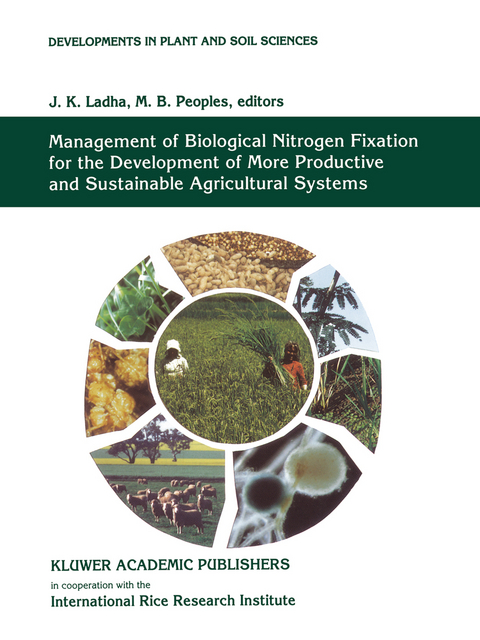
Management of Biological Nitrogen Fixation for the Development of More Productive and Sustainable Agricultural Systems
Springer (Verlag)
978-0-7923-3413-2 (ISBN)
Table 1. Global allocation of arable land between different com modities Globally, cereal cropping dominates cultivated land Commodities' Proportion of land area use (around 50% of total area, Table I). The remain (%) ing arable land is used for production of oilseed, fibre, or food and cash crops. In addition, vast areas are Cereals maintained under temporary or permanent pasture for Wheat 16 forage production (2-3 fold greater than the total area Rice 10 under cultivation and permanent crop; Table 1, Fig. Maize 9 O. All cultivated crops, except for legumes (pulses All other cereals 13 and legume oilseeds) require the soil to provide rel Total 48 atively large amounts of nitrogen (N). It is necessary for the three most important cereals, wheat (Triticum Legumes aestivum), rice (Oryza sativa) and maize (Zea mays), Legume pulses 5 1 to take up 20 to 40 kg soil N ha- over a period of 3 Legume oilseeds 6 to 5 months to satisfy the N requirements of the seed and supporting vegetative structure for each tonne of Total II grain produced (e. g. Fig. 2; Myers, 1988). Produc tive pastures on the other hand may assimilate> 100 Other crops kg N ha -/ each annum, of which 50 to 90% will be Other oilseeds 6 consumed by livestock in intensively grazed systems Beverages I Tobacco 7 (Ledgardy, 1991; Thomas, 1995).
1. Biological nitrogen fixation: An efficient source of nitrogen for sustainable agricultural production?.- 2. Sustainable agriculture in the semi-arid tropics through biological nitrogen fixation in grain legumes.- 3. Enhancing crop legume N2 fixation through selection and breeding.- 4. Enhancing legume N2 fixation through plant and soil management.- 5. Role of legumes in providing N for sustainable tropical pasture systems.- 6. Management of biological N2 fixation in alley cropping systems: Estimation and contribution to N balance.- 7. Manipulation of rhizobia microflora for improving legume productivity and soil fertility: A critical assessment.- 8. Green manure technology: Potential, usage, and limitations. A case study for lowland rice.- 9. Biological nitrogen fixation associated with sugar cane and rice: Contributions and prospects for improvement.- 10. Biological N2 fixation by heterotrophic and phototrophic bacteria in association with straw.- 11. Potential and pitfalls of trying to extend symbiotic interactions of nitrogen-fixing organisms to presently non-nodulated plants, such as rice.- 12. New techniques for studying competition by Rhizobia and for assessing nitrogen fixation in the field.- 13. Future benefits from biological nitrogen fixation: An ecological approach to agriculture.- 14. Research evaluation and impact analysis of biological nitrogen fixation.- Author index.
| Erscheint lt. Verlag | 30.9.1995 |
|---|---|
| Reihe/Serie | Developments in Plant and Soil Sciences ; 65 |
| Zusatzinfo | VI, 291 p. |
| Verlagsort | Dordrecht |
| Sprache | englisch |
| Maße | 210 x 279 mm |
| Themenwelt | Naturwissenschaften ► Biologie ► Mikrobiologie / Immunologie |
| Naturwissenschaften ► Biologie ► Ökologie / Naturschutz | |
| Naturwissenschaften ► Geowissenschaften ► Geologie | |
| Technik | |
| ISBN-10 | 0-7923-3413-2 / 0792334132 |
| ISBN-13 | 978-0-7923-3413-2 / 9780792334132 |
| Zustand | Neuware |
| Haben Sie eine Frage zum Produkt? |
aus dem Bereich


